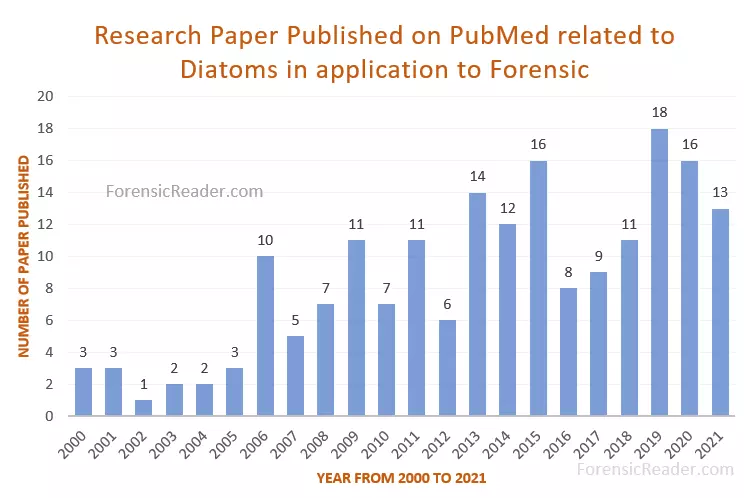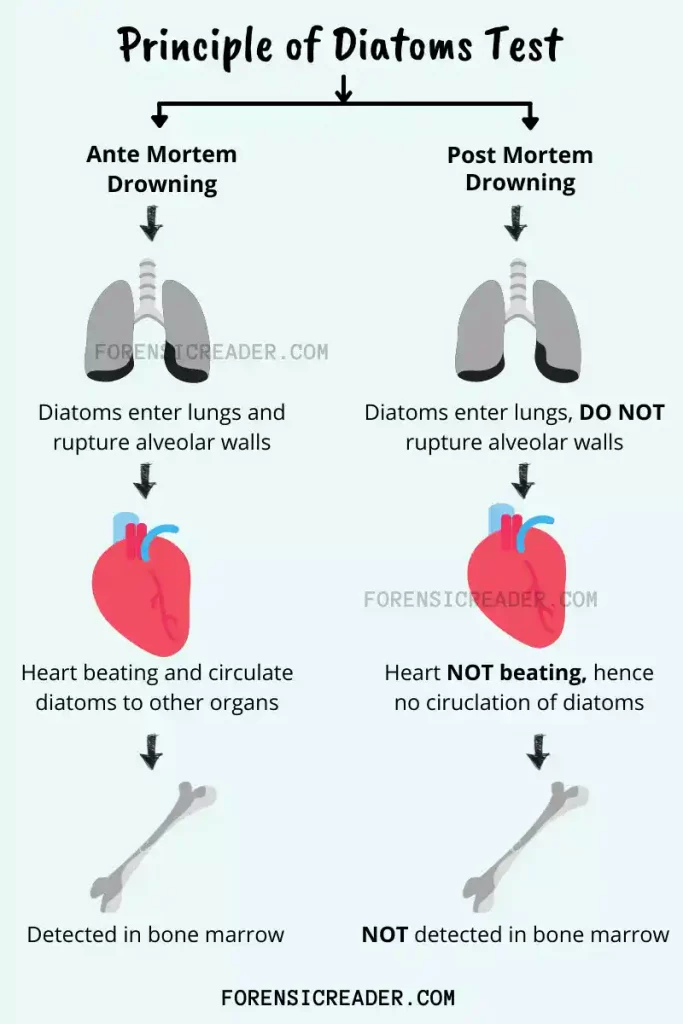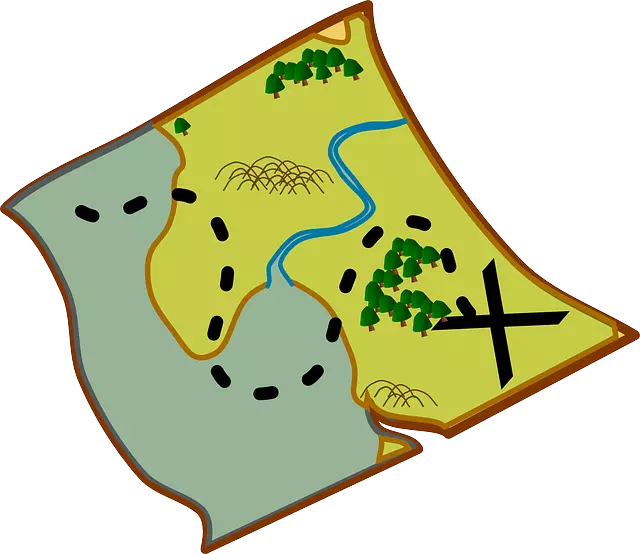Diatoms not only share 20% of oxygen production, but their contributing % is significantly higher in resolving drowning-related cases. And there is a specific forensic discipline that defines the legal importance of diatoms to forensic cases. It is called Forensic Limnology.
Forensic Limnology, by definition, is the study of freshwater ecology for the presence of diatoms (particularly) in order to solve forensic and medical cases.
Does this imply that forensic limnology is equivalent to all diatom analyses? Not truly. Because it doesn’t include seawater diatoms. Now, let’s take a look at How Diatoms aids Forensic Science in solving a crime?
1. Solving Numerous Cases
Diatoms significance is not only just a number for solving and closing cases. The research on finding them and new techniques give more opportunities for their development and aid in solving crimes.
For instance, diatoms are commonly used in drowning cases. And it is nearly impossible to keep track of the number of cases solved with diatoms, as in the United States alone— 11 cases a day. This number would be in the thousands for the entire world.
So, to make it simple, I use numbers of research papers published on PubMed as the metric for diatom significance in forensic science. The graph below depicts the number of research articles published each year related to the forensic applications of diatoms.

2. Helps in Identifying Antemortem Drowning
When the water enters the lungs, it causes violent respiration that leads to rupturing the alveolar walls. If the water contains diatoms less than 40 µm, it passes through pulmonary veins and lymph channels towards the left ventricle of the heart. And finally to peripheral organs such as bone, liver, brain, skeletal muscle, etc.
But in case of no respiration, the water with diatoms enter the lungs passively resulting in diatoms in the lungs but they aren’t propagated to other peripheral organs because of:
- no alveolar wall rupture
- cease of circulation system
Thus, in both drowning cases, diatoms may be present in the lungs, but diatoms in peripheral organs are the classic sign of ante-mor-tem drowning.
| Presence of diatoms | Lungs | Peripheral Organs |
| Breathing when entering the water | Yes | Yes |
| Died before entering water | Yes | No |

3. Identify Homicidal, Suicidal, Accidental
It is clear that diatoms in peripheral organs are the sign of ante-mor-tem drowning. This indicates that the person is conscious and alive while drowning. So, it could be a case of homicidal, suicidal, or accidental.
When diatoms are solely found in the lungs, it indicates the person is not-alive or unconscious (induced coma) while drowning. And it’s very certainly homicidal (99%), with very little probability of being suicidal or accidental.
According to many researchers, “diatoms at peripheral organs are always homicidal.” But, in my opinion, they are only 99% correct. I know it could be less than 1% (or more) but it is possible. The following are some of the possibilities that I believe exist— comment what you thought?
| Possibility | Description |
|---|---|
| Shock of falling in water | Fear causes heart failure and ceases circulatory system that resists the transportation of diatoms to various part |
| Cold shock (jumping into iced water) | Heart failure due to vasoconstriction (heart need to pump harder the same volume of blood) |
| Fell and injury cause unconsciousness | Fells and road accidents make a person unconscious (or coma) before falling into the water |
4. Site of Drowning
Body found at site ‘A’— check. Ante-mortem downing— check. What’s now? Is the person drawn in the same water or not?
For this, a sample from the body and water (from possible sites) should be matched. If no correlation is seen, it suggests the body might be moved, which again, by natural flowing of water current or by someone.
In general, diatoms are very collective in their occurrence and specific to locations. You can’t find a single type of diatom everywhere. This makes individualizing the drowning site possible.

So, if Sam’s body was discovered in the Colorado River region of Arizona (sorry for killing Sam) and diatoms indicate a different site of origin, it is clear that the body was moved either by a water current or by someone.
Plus, there is a specific term that is used by forensic scientists for finding the possible area of origin of diatoms, called forensic diatomology or Diatomological Mapping (D-Mapping).
5. Time of Drowning— Diatom Fingerprinting
Now let’s take a look, how the above situation can be useful in identifying the time of the drowning. For this, studying diatom communities through time in chronological order comes in handy (and called to be diatom fingerprinting).
In fact, species not only differ from drowning site to drowning site but also differ because of seasonality (and other factors). This is due to the tolerance of these microalgae organisms to factors such as salinity, temperature, pH, nutrients, and vegetation. All these differences contribute to the livelihood of diatoms.
Thus, if Sam drowned in winter and his skeleton remains were discovered and examined in summer, there is a greater chance that diatoms cannot be matched subsequently.
Also Read:
- Draughtsman Appearance: Colonies Structure & Morphology
- Burtonian Line: Cause, Color, Mechanism, Symptoms
- Danbury Tremor and Hatters Shake: Causes, Signs, and Symptoms
6. Identification of Possible Stature
Wonder! How finding stature with diatoms is even possible? It is possible. And more importantly, backed by research.
A study conducted in 2017 by the Department of Security and Crime Science and the Department of Geography, London, on “Can diatoms be transferred and retained on various footwear materials.” Five different footwear materials were used for the period of immersion from 30 seconds to 30 minutes. [PubMed]
| Immersion | Canvas | Leather | Rubber | Polyurethane |
| 30 sec | + | — | — | — |
| 3 min | + | + | + | + |
| 30 min | + | + | + | + |
The study concluded:
- Soaked footwear can retain diatoms even with a short immersion period.
- Possible diatom identification can be carried out even after 168 hours of immersion.
- More effective when shoes are made from mixed materials and polymers.
So, once that shoe size is positive for diatoms of the same nature, you can easily plug the shoe size into a regression equation to determine the assailant’s or victim’s height. It can also assist the forensic examiner in rolling out or including any suspects in the case.
7. Identify Possible Body Type
Body type can easily define by clothing. So, let’s talk about clothes and diatoms. Is there any possibility of having diatoms on the fabrics?
To answer this question, Scott and his colleagues conducted a study (published on Researchgate) on finding diatoms on clothing in 2014, London. They prove that diatoms can be transferred to clothing. Here’s what they discovered in their research:
- Diatoms transfer to clothing from water and wet soil at shores as evidence.
- Even short-term contact transfer them to fabrics.
- Best extraction method for diatoms from clothing is perhydrol digestion.
- Cotton clothes can resist diatom cleaning and can be identified even after washing.
8. May Identify Assailant

These above two factors— stature and body type— can line down the investigation to a specific group of people (including gender). Furthermore, finding diatoms in a living person is not legal (as surgery is required). So, their clothing and shoes might dictate whether he or she immerses in the same water body where the victim drowned.
These two pieces of evidence are supportive evidence against the culprit but DNA on clothes can make it more absolute. And if DNA is found, it is like icing on the cake for investigators on finding the responsible guy.
Now, it’s on the suspect on how he/she explained diatoms or DNA on the clothing or shoes and their relation to the case.
9. Diatoms Not only for Drowning
You probably think diatoms are only seen in the bone marrow of drowners. But it is only half true. They can also be found in the bone marrow and peripheral organs of people who have not drowned. This is based on the fact that the diatoms may be airborne and ingested.
No surprise that these microalgae are present in the air which comments on their appearance in the lungs. Similarly, if the person ingested them for a long time, they can even circulate to the whole body organ and make the possibility of finding them in bone marrow and organs.
This also helps in body identification. For example, suppose ‘A’ lived in southern Arizona and ingested diatoms from drinkable sources and inhaled them from the air throughout her life. And if she traveled to another region where these diatoms aren’t found, it can be traced back to her birthplace.
10. Diatoms in Forensic Veterinary
Finding diatoms in animals can assess whether they are drowned or not.
Research published in 2013 by Benson et al. defines the potential of finding diatoms in case of aspirated water and animal drowning. [Source]
And, in 2017, Fucci et al. published a study that extracted and identified diatoms in various drowned animals. The extraction process used for the study is hydrogen peroxide digestion and extracted from the lungs, liver, and kidney. They also assess the possibility of diatoms being a result of drinking contaminated water during their lifetime. [Source]
References:
- Role of diatoms in the world of forensic science by Verma K [Researchgate]
- Diatoms in forensic Science by Peabody [ScienceDirect]
- The potential of forensic analysis on human bones… by Damien et al. [Source]
- False-positive diatom test: A real challenge?… by Lunetta P. et al. [PubMed]
Also Read:
- Forensic Analysis of Diatoms in Drowning: Extraction and Procedure
- Offensive Vs Defensive Wounds: Forensic Injuries & Medico-Legal Importance
- Age Estimation From Teeth: All Forensic Odontology Tables Included
- Development of Bloody Fingerprint: Chemical Test and Techniques
- Presumptive Tests for Blood: 11 Important Forensic Test Included

FR Author Group at ForensicReader is a team of Forensic experts and scholars having B.Sc, M.Sc, or Doctorate( Ph.D.) degrees in Forensic Science. We published on topics on fingerprints, questioned documents, forensic medicine, toxicology, physical evidence, and related case studies. Know More.
